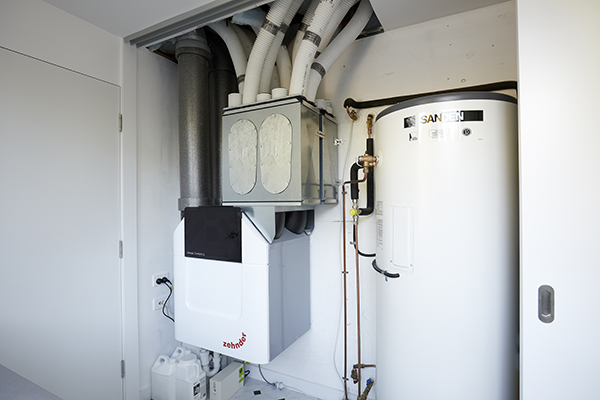How HRV Enhances Indoor Air Quality and Comfort at Home
Wiki Article
How Heat Recovery Ventilation Boosts Indoor Air Quality and Reduces Energy Prices
Heat Recovery Ventilation (HRV) systems play a crucial role in boosting indoor air top quality while at the same time decreasing energy costs. By efficiently trading stagnant indoor air with fresh outside air, HRVs aid maintain ideal humidity and lower pollutants. In addition, their ability to recuperate warm from outgoing air decreases the strain on home heating and cooling systems. As energy expenses proceed to rise, comprehending the complete potential of HRV systems ends up being increasingly vital for house owners and organizations alike.Understanding Heat Recovery Ventilation Systems

Heat recovery ventilation (HRV) systems play a crucial duty in enhancing indoor air top quality, specifically in modern, energy-efficient buildings. These systems are developed to transfer warm from the outward bound stagnant air to the inbound fresh air, therefore minimizing energy loss while preserving suitable temperature level degrees inside. HRVs contain a warmth exchanger, followers, and ductwork, promoting the continual blood circulation of air. By removing indoor pollutants and introducing fresh air, HRVs aid to stabilize moisture degrees, prevent mold and mildew development, and lower irritants. The performance of HRV systems depends on their capacity to recoup as much as 80% of the heat from the exhausted air, advertising energy conservation while making certain a healthy and balanced indoor environment. Their assimilation is essential in accomplishing lasting living methods.
The Importance of Indoor Air Top Quality
Indoor air quality (IAQ) is a vital factor affecting the wellness and wellness of passengers in any setting. Poor IAQ can cause various health and wellness issues, consisting of breathing troubles, allergies, and exhaustion. Furthermore, it can intensify status quo such as asthma. Variables contributing to reduced IAQ consist of pollutants from interior resources like cleaning representatives, mold, and insufficient air flow. Maintaining great IAQ is essential for promoting a safe and comfortable living or functioning room. Effective strategies to enhance IAQ include normal monitoring of air quality, appropriate air flow systems, and decreasing the usage of damaging materials inside. By focusing on IAQ, individuals can assure a healthier environment that promotes efficiency and general high quality of life.Energy Performance Conveniences of HRV Equipments
Lots of house owners and building supervisors are significantly acknowledging the energy performance benefits of heat recuperation air flow (HRV) systems. By transferring heat from worn down indoor air to incoming fresh air, HRV systems considerably reduce the power needed for heating & cooling. This process lessens reliance on typical HVAC systems, bring about reduced energy costs. Additionally, HRVs aid keep a balanced interior climate, avoiding excessive home heating or cooling down demands. The capacity to recuperate approximately 90% of the warm from outbound air additionally supports sustainability initiatives by lowering general energy intake. HRV systems add not only to cost financial savings however additionally to a decreased carbon impact, aligning with the growing focus on energy-efficient building methods.Installment and Maintenance Considerations
The reliable implementation of warm recuperation air flow (HRV) systems requires mindful consideration of setup and upkeep factors to guarantee peak efficiency. Correct positioning of the HRV unit is crucial, as it ought to be set up in an area that takes full advantage of air movement while minimizing sound disturbance. In addition, ductwork must be properly sized and shielded to protect against energy loss. Routine maintenance, including filter replacement and system cleansing, is critical to secure optimum performance and indoor air quality. Owners must develop a normal upkeep timetable to identify and deal with possible concerns prior to they rise. Cooperation with seasoned specialists throughout both setup and maintenance phases can enhance the longevity and efficiency of HRV systems, ultimately leading to far better indoor atmospheres and decreased energy prices.
Real-World Applications and Success Stories
Discovering real-world applications of warm recuperation air flow (HRV) systems exposes their considerable effect on interior air high quality and energy efficiency throughout different settings. In residential structures, home owners have reported improved air quality, resulting in fewer allergic reactions and respiratory problems. Schools executing HRV systems have actually noted boosted trainee focus and minimized absenteeism because of better air flow. Commercial structures, such as offices and retail rooms, have experienced lower power costs and boosted staff member efficiency. A corporate office in a warm environment achieved a 30% reduction in power bills after setting up an HRV system. These success tales demonstrate that HRV innovation not just adds to much healthier environments however likewise gives tangible financial advantages, making it a beneficial financial investment for various industries.Often Asked Inquiries
Can HRV Equipments Reduce Allergens in Indoor Air?
The effectiveness of HRV systems in decreasing interior irritants largely rests on their ability to filter and exchange air. HRV Heat Recovery Ventilation. By constantly changing stale air, these systems can considerably decrease irritant degrees throughout interior environments
Exactly How Does Humidity Affect HRV System Performance?
Humidity considerably affects HRV system efficiency; high levels can bring about condensation, lowering efficiency, while low humidity might enhance air exchange. Balancing humidity is important for perfect operation and maintaining indoor air top quality.Are HRV Equipments Noisy Throughout Procedure?
HRV systems can create varying noise degrees during operation, depending on their design and installation. Some units run silently, while others may generate noticeable sound, specifically at greater air flow settings or when poorly kept.What Is the Ordinary Life Expectancy of an HRV System?
HRV Heat Recovery Ventilation
Can HRV Systems Be Used in All Climates?
HRV systems can be made use of in numerous environments, however their effectiveness might differ - HRV Heat Recovery Ventilation. In extreme temperatures, adjustments or supplemental systems might be necessary to assure suitable efficiency and comfort while keeping interior air qualityReport this wiki page